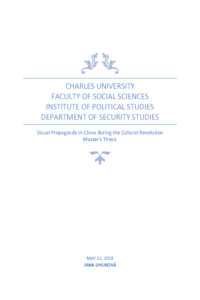Chinese Visual Propaganda
Čínská vizuální propaganda
diplomová práce (OBHÁJENO)

Zobrazit/
Trvalý odkaz
http://hdl.handle.net/20.500.11956/101223Identifikátory
SIS: 199241
Kolekce
- Kvalifikační práce [18431]
Autor
Vedoucí práce
Oponent práce
Kučera, Tomáš
Fakulta / součást
Fakulta sociálních věd
Obor
Mezinárodní bezpečnostní studia
Katedra / ústav / klinika
Katedra mezinárodních vztahů
Datum obhajoby
6. 9. 2018
Nakladatel
Univerzita Karlova, Fakulta sociálních vědJazyk
Angličtina
Známka
Velmi dobře
Klíčová slova (česky)
China, propaganda, visual semiotics, symbols, discourseKlíčová slova (anglicky)
China, propaganda, visual semiotics, symbols, discourseAnalysing discourse through visual units is certainly a very fascinating and interesting way of showing how propaganda posters regulate and shape the beliefs, values, and attitudes of social groups. Based on the theory of social constructionism, this research paper aims to explore and examine the use of verbal and nonverbal symbols between the propagandist and the audience in which the social positions of difference and authority are articulated. To accomplish this, I choose six propaganda posters that resonated strongly within the Chinese society to reflect how their symbolic messages and linguistic codes serve as transmitters of certain ideas. I incorporated testimonies of Anchee Min, Duo Duo, and Saul Yeung as a form of evidence in revealing the cultural significance, social practices, and power relations because they all have knowledge and experience in the cultural, social, and political discourse during the Cultural revolution. By applying a hermeneutic approach, this research paper deconstructs the symbolic meanings and linguistic codes of propaganda posters to reveal the notion of communication competence between the propagandist and the audience. Key words: China, propaganda, visual semiotics, symbols, discourse
